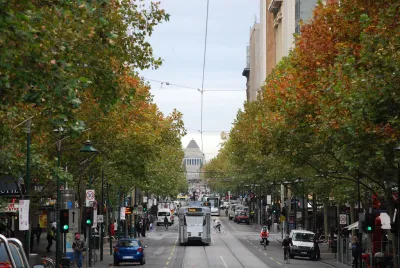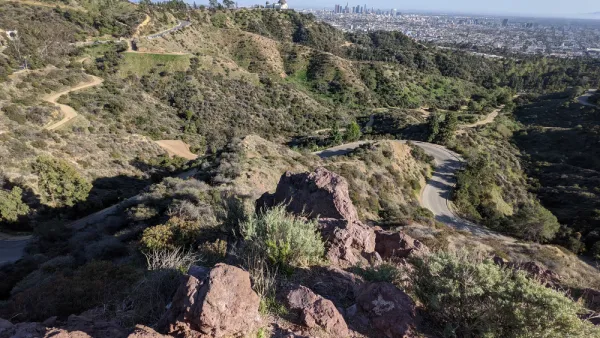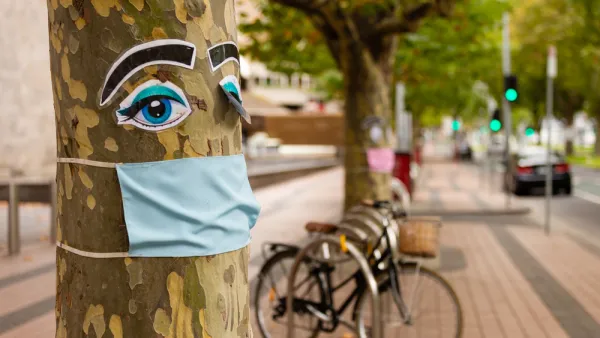In the mid-1980s, a tug-of-war over the future of one of Melbourne, Australia's most important streets took place with those wanting full pedestrianization realizing their vision for one brief, shining moment.

In February 1985, for a brief window of time, Melbourne's Swanston Street was transformed from asphalt carrying vehicles and a tram to a pedestrian promenade covered in grass. The urban intervention, as described by Lucy Salt in the Kill Your Darlings journal, was the product of a hard fought struggle between the state Ministry for Planning and Environment and the City of Melbourne. The state ministry was led by Professor David Yencken who, along with his team, had advocated the street be limited to pedestrians on a full-time basis. The city had rejected the state's plans, instead seeking a partial pedestrianization of the street allowing some vehicles to move through.
In early 1985, as part of the 150-year anniversary celebration of the state of Victoria, Yencken's team got their wish at least for a few days. At a cost of $550,000, the entire street was covered in fresh sod for one weekend.
After months of preparation, [Yencken's team member Sonja Peter] remembers watching the crowds promenade, take in the performances, play ball, walk their dogs, or simply sit. The massive pop-up park had completely transformed the street and set to work on people’s imaginations.
‘The acoustics changed, the smell and whole feeling changed, so people responded immediately to that,’ says Peter.
When the wet grass became muddy, people took off their shoes and strolled along. Peter also recalls feeling vindicated upon seeing the reactions of the ministry staff who’d come down to help out.
‘No-one knew what we had in mind, there was a lot of scepticism, and so to unroll the event by laying out the grass was spectacular.’
The grass had removed all trace of the traffic from the street, with the exception of a marooned W-Class tram standing as a proud centrepiece. The sun-warmed grass, wrote John Lahey in the Age, ‘smelled like the mouldering hay on a Gippsland farm’.
Yencken remains proud of the transformation of Swanston Street, although it was short lived. He sees Swanston Street as a pre-cursor to other urban interventions, including New York's Time Square, to which he gives a somewhat backhanded compliment: "New York now writes up the fact that they painted some spaces on Broadway and put a few pot plants out: Isn’t it revolutionary? And you’re going, Guys? Thirty years ago? And it wasn’t painted, it was actually grass!’
FULL STORY: Imagine a City: Swanston Street Party and the greening of Melbourne

Analysis: Cybertruck Fatality Rate Far Exceeds That of Ford Pinto
The Tesla Cybertruck was recalled seven times last year.

National Parks Layoffs Will Cause Communities to Lose Billions
Thousands of essential park workers were laid off this week, just before the busy spring break season.

Retro-silient?: America’s First “Eco-burb,” The Woodlands Turns 50
A master-planned community north of Houston offers lessons on green infrastructure and resilient design, but falls short of its founder’s lofty affordability and walkability goals.

Test News Post 1
This is a summary

Analysis: Cybertruck Fatality Rate Far Exceeds That of Ford Pinto
The Tesla Cybertruck was recalled seven times last year.

Test News Headline 46
Test for the image on the front page.
Urban Design for Planners 1: Software Tools
This six-course series explores essential urban design concepts using open source software and equips planners with the tools they need to participate fully in the urban design process.
Planning for Universal Design
Learn the tools for implementing Universal Design in planning regulations.
EMC Planning Group, Inc.
Planetizen
Planetizen
Mpact (formerly Rail~Volution)
Great Falls Development Authority, Inc.
HUDs Office of Policy Development and Research
NYU Wagner Graduate School of Public Service



























